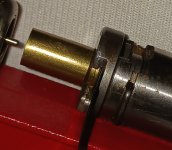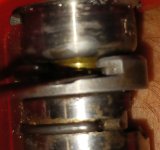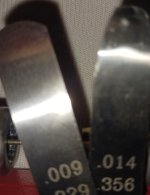Marco Califo
New member
I got around to sizing some of my 9mm 1997 NATO brass. I had already swaged the Primer pockets on the Dillion tool.
The sizing die is a Lee cheap one. My practice is to not lube straight walled pistol cases. I tumbled the ready to size brass, Dry FARTing, with a teaspoon of melted beeswax in fresh corn cob. This maintained the shine and probably functions as a minimalist lube, I do not plan on removing.
When I started sizing, and checking sized cases in a case guage. About 2/3 sized OK. The other 1/3 would not go all the way into the case guage. I started adding paper products under the case in the shellholder (Lyman). Double thickness of index cards, cut to fit, gave me better results.
I remembered Guffy (whose posts I could not read through) using a feeler guage to raise the brass in the shellholder. I got a feeler guage, measured my "paper" and selected 14/1000". I then had to trim the feeler blade enough to fit using a steel file and elbow Grease.
So, I have resized 100+ successfully using the shim apparatus.
It seems the military 9mm brass varies between:
1. Like commercial, and,
2. Hot carbine loads, or oversized chambers, or other factors..
This is the first time I needed to use the feeler guage technique.
The sizing die is a Lee cheap one. My practice is to not lube straight walled pistol cases. I tumbled the ready to size brass, Dry FARTing, with a teaspoon of melted beeswax in fresh corn cob. This maintained the shine and probably functions as a minimalist lube, I do not plan on removing.
When I started sizing, and checking sized cases in a case guage. About 2/3 sized OK. The other 1/3 would not go all the way into the case guage. I started adding paper products under the case in the shellholder (Lyman). Double thickness of index cards, cut to fit, gave me better results.
I remembered Guffy (whose posts I could not read through) using a feeler guage to raise the brass in the shellholder. I got a feeler guage, measured my "paper" and selected 14/1000". I then had to trim the feeler blade enough to fit using a steel file and elbow Grease.
So, I have resized 100+ successfully using the shim apparatus.
It seems the military 9mm brass varies between:
1. Like commercial, and,
2. Hot carbine loads, or oversized chambers, or other factors..
This is the first time I needed to use the feeler guage technique.
Last edited:



